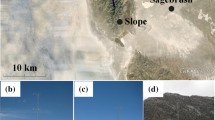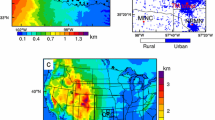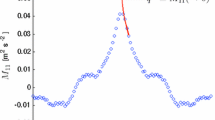Abstract
The impacts of background (or ambient) and local atmospheric thermal stabilities, and slope steepness, on nighttime thermally induced downslope flow in meso-β domains (i.e., 20–200 km horizontal extent) have been investigated using analytical and numerical model approaches. Good agreement between the analytical and numerical evaluations was found. It was concluded that: (i) as anticipated, the intensity of the downslope flow increases with increased slope steepness, although the depth of the downslope flow was found to be insensitive to slope steepness in the studied situations; (ii) the intensity of the downslope flow is generally independent of background atmospheric thermal stability; (iii) for given integrated nighttime cooling across the nocturnal boundary layer (NBL), Q s the local atmospheric thermal stability exerts a strong influence on downslope flow behavior: the downslope flow intensity increases when local atmospheric thermal stability increases; and (iv) the downslope flow intensity is proportional to Q s 1/2.
Similar content being viewed by others
References
Arya, S. P. S.: 1972, ‘The Critical Condition for the Maintenance of Turbulence in Stratified Flows’, Quart. J. Roy. Meteorol. Soc. 98, 264–273.
André, J. C. and Mahrt, L.: 1982, ‘The Nocturnal Surface Inversion and Influence of Clear-air Radiative Cooling’, J. Atmos. Sci. 39, 864–878.
Blackadar, A. K.: 1979, ‘High Resolution Models of the Planetary Boundary Layer’, in J. Pfafflin and E. Ziegler (eds.), Advances in Environmental Science and Engineering 1 Gordon and Breach, pp. 50–85.
Brost, R. A. and Wyngaard, J. C.: 1978, ‘A Model Study of the Stable Stratified Planetary Boundary Layer’, J. Atmos. Sci. 35, 1427–1440.
Dickerson, M. H. (ed.): 1980, A Collection of Papers Based on Drainage Wind Studies in the Geysers Area of Northern California: Part I, UCID-18884, ASCOT-80-7, 22 chapters.
Dickerson, M. H. and Gudiksen, P. H. (Eds.): 1983, ‘Atmospheric Studies in Complex Terrain’, Technical Progress Report FY-1979 through FY-1983. Lawrence Livermore National Laboratory, UCID-19851, ASCOT84-1, 367pp.
Doran, J. C. and Horst, T. W.: 1983. ‘Observations and Models of Simple Nocturnal Slope Flows’, J. Atmos. Sci. 40, 708–717.
Ellison, T. H. and Turner, J. S.: 1959, ‘Turbulent Entrainment in Stratified Flows’, J. Fluid Mech., 6, 423–448.
Garratt, J. R. and Ryan, B. F.: 1989, ‘The Structure of the Stable Stratified Internal Boundary Layer in Offshore Flow over the Sea’, Boundary Layer Meteorol. 47, 17–40.
Kondo, H.: 1984, ‘The Difference of the Slope Wind Between Day and Night’, J. Meteorol. Soc. Japan 62, 224–232.
Mahrer, Y. and Pielke, R. A.: 1977, ‘A Numerical Study of the Air Flow over Irregular Terrain’, Contrib. Atmos. Phys. 50, 98–113.
Manins, P. C. and Sawford, B. L.: 1979a, ‘Katabatic Winds: A Field Case Study’, Quart. J. Roy. Meteorol. Soc. 105, 1011–1025.
Manins, P. C. and Sawford, B. L.: 1979b, ‘A Model of Katabatic Winds’, J. Atmos. Sci. 36, 619–630.
McNider, R. T. and Pielke, R. A.: 1981, ‘Diurnal Boundary-Layer Development over Sloping Terrain’, J. Atmos. Sci. 38, 2198–2212.
McNider, R. T. and Pielke, R. A.: 1984, ‘Numerical Simulation of Slope and Mountain Flow’, J. Climate Appl. Meteorol. 23, 1441–1453.
Nappo, C. J. and Rao, K. S.: 1987, ‘A Model Study of Pure Katabatic Flows’, Tellus 39A, 61–71.
Nieuwstadt, F. T. H.: 1985, ‘A Model for the Stationary, Stable Boundary Layer’, in J. C. R. Hunt (ed.), Turbulence and Diffusion in Stable Environment, Clarendon Press, Oxford, pp. 149–179.
Nieuwstadt, F. T. H. and Tennekes, H.: 1981, ‘A Rate Equation for the Nocturnal Boundary-Layer Height’, J. Atmos. Sci. 38, 1418–1428.
Pielke, R. A.: 1974, ‘A Three-Dimensional Numerical Model of the Sea Breezes over South Florida’, Mon. Wea. Rev. 102, 115–239.
Prandtl, L.: 1942, ‘Fuehrer durch die Stromunglehre. Braunschweig’, Viewing und Sohn, 382pp.
Rao, K. S. and Snodgrass, H. F.: 1981, ‘A Non-Stationary Nocturnal Drainage Flow Model’, Boundary Layer Meteorol. 20, 309–320.
Segal, M., Mahrer, Y., and Pielke, R. A.: 1982, ‘Application of a Numerical Mesoscale Model for Determining Persistent Regional Climatological Patterns’, J. Appl. Meteorol. 21, 1754–1762.
Yamada, T.: 1979, ‘Prediction of the Nocturnal Surface Inversion Height’, J. Appl. Meteorol. 18, 526–531.
Yasuda, N., Kondo, J., and Sato, T.: 1986, ‘Drainage Flow Observed in a V-shaped Valley’, J. Meteorol. Soc. Japan 64, 283–301.
Author information
Authors and Affiliations
Rights and permissions
About this article
Cite this article
Ye, Z.J., Garratt, J.R., Segal, M. et al. On the impact of atmospheric thermal stability on the characteristics of nocturnal downslope flows. Boundary-Layer Meteorol 51, 77–97 (1990). https://doi.org/10.1007/BF00120462
Accepted:
Issue Date:
DOI: https://doi.org/10.1007/BF00120462




